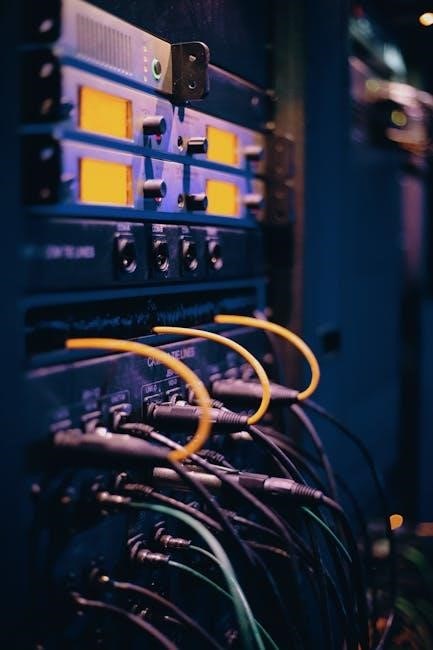100 Amp Manual Transfer Switch: An Overview
What is a 100 Amp Manual Transfer Switch?
A 100 amp manual transfer switch is a device used to safely switch between utility power and a backup generator during power outages․ This switch allows homeowners to manually connect a generator to power essential circuits․
Common applications include residential homes and small businesses․ They ensure power to essential appliances like refrigerators, lighting, and heating systems when the main electrical grid fails․ This prevents food spoilage and maintains comfort during outages․
What is a 100 Amp Manual Transfer Switch?
A 100 amp manual transfer switch is an electrical device designed to safely switch a building’s power source between the utility grid and a backup generator․ Unlike automatic transfer switches, it requires a person to manually operate the switch during a power outage․ This manual operation ensures that the generator’s power doesn’t backfeed into the utility lines, which could endanger utility workers․
These switches are typically installed next to the main electrical panel․ They are wired to specific circuits within the home or building, allowing users to select which circuits will receive power from the generator․ This targeted power distribution helps manage the generator’s load and ensures essential appliances, like refrigerators, sump pumps, and lighting, remain operational during an outage․ Manual transfer switches are a cost-effective solution for homeowners seeking reliable backup power without the expense of an automatic system․ They provide a secure and controlled method for switching power sources․
Typical Applications of a 100 Amp Manual Transfer Switch
100 Amp Manual Transfer Switches find their primary application in residential settings, offering homeowners a reliable method to power essential circuits during grid outages․ These circuits often include lighting, refrigerators, heating systems, and critical medical equipment․ By manually switching to generator power, homeowners can maintain a degree of normalcy and safety during emergencies․
Beyond residential use, small businesses also benefit from 100 amp manual transfer switches․ They allow businesses to keep vital operations running, such as computer systems, security systems, and communication equipment․ In rural areas, where power outages are more frequent, these switches are particularly valuable․ They ensure consistent power for homes and businesses, safeguarding against disruptions caused by severe weather or grid failures․ The manual nature of the switch provides users with direct control over their power source, offering peace of mind and energy independence when the utility grid is unavailable․

Key Features and Benefits
A key feature is the safe transfer of power, preventing backfeeding into the utility grid, which protects utility workers․ Cost-effectiveness and manual operation are also significant benefits, offering an affordable backup solution․
Ensuring Safe Power Transfer
Ensuring safe power transfer is paramount when utilizing a 100 amp manual transfer switch․ These devices prevent dangerous backfeeding of generator power into the utility grid․ Backfeeding can severely harm utility workers repairing downed lines, creating a potentially lethal situation․ A manual transfer switch isolates the generator from the utility lines․ This isolation ensures that power flows only to the designated circuits within the home or building and not back into the external power grid․
This safety measure is crucial in preventing electrical accidents and maintaining a safe environment during power outages․ Additionally, safe power transfer protects the generator itself from potential damage caused by voltage fluctuations or surges from the utility side․ Proper installation and adherence to safety guidelines are essential for the safe and effective operation of the manual transfer switch, ensuring peace of mind during emergencies․
Cost-Effectiveness of Manual Switches
Manual transfer switches offer a cost-effective solution for homeowners seeking backup power during outages․ Compared to automatic transfer switches, manual models generally have a lower initial purchase price, making them an attractive option for budget-conscious consumers․ The installation costs are also typically lower, as manual switches require less complex wiring and setup procedures․
Furthermore, manual transfer switches do not require ongoing maintenance or monitoring systems that automatic switches often entail, reducing long-term expenses․ While manual switches require the user to manually switch between utility and generator power, the savings in upfront and maintenance costs can make them a worthwhile investment for those comfortable with this manual operation․ The overall cost-effectiveness of manual switches makes them a popular choice for reliable backup power․

Installation Considerations
Proper installation requires essential tools like screwdrivers, wire strippers, and a multimeter․ Necessary materials include appropriately sized wiring, conduit, and connectors rated for 100 amps․ Always consult local electrical codes before starting installation․
Essential Tools and Materials
Installing a 100 amp manual transfer switch requires specific tools and materials to ensure a safe and effective setup․ Essential tools include a high-quality screwdriver set, wire strippers, a reliable multimeter for testing voltage, and a conduit bender if conduit is needed․ A voltage tester is crucial for verifying power is off before working․
Materials needed are appropriately sized copper or aluminum wiring (typically 12-1 AWG/kcmil), electrical tape, wire connectors, and conduit for protecting the wiring․ A NEMA type-3R enclosure is recommended for outdoor installations to protect the switch from weather․ Always refer to local electrical codes and the transfer switch manual for specific wiring requirements and safety guidelines․
A fault current identification label is also necessary, as required by the 2017 NEC․ Remember to prioritize safety by wearing appropriate personal protective equipment such as safety glasses and gloves during the installation process․ Correctly sized breakers are critical for safety․ A drill might be required to make holes․
Step-by-Step Installation Guide
Before beginning, ensure the main power is OFF․ Mount the 100 amp manual transfer switch near the main service panel․ Connect the generator inlet box to the transfer switch using appropriately sized conduit․ Next, wire the transfer switch to the main panel, carefully following the wiring diagram provided with the switch․
Connect the generator input wires to the designated terminals on the transfer switch․ Ensure all connections are tight and secure․ Label each wire to avoid confusion during future maintenance․ After wiring, inspect all connections and ensure proper grounding․ Test the switch by starting the generator and switching the load from utility to generator power․
Verify that all selected circuits are functioning correctly․ Finally, document the installation process and keep the manual readily accessible․ If any step is unclear, consult a qualified electrician․ Always adhere to local electrical codes and regulations․ A professional installation ensures safety and optimal performance․ Use the one-touch button․
Safety Precautions During Installation
Prioritize safety by disconnecting the main power supply before commencing any work․ Always wear appropriate personal protective equipment, including safety glasses and insulated gloves․ Never work on electrical systems in wet or damp conditions, as this drastically increases the risk of electric shock․
Double-check all wiring connections to ensure they are tight and properly insulated․ Use a voltage tester to verify that circuits are de-energized before handling wires․ Follow the manufacturer’s instructions precisely and adhere to local electrical codes․ Incorrect wiring can lead to fire hazards or equipment damage․
If you are not comfortable working with electrical systems, hire a qualified electrician․ Ensure the generator is properly grounded to prevent electrical hazards․ Keep a fire extinguisher nearby during the installation process․ After installation, test the system thoroughly to confirm it functions correctly․ Regularly inspect the transfer switch for any signs of wear or damage․

Wiring and Connections
Proper wiring is crucial for safe and effective operation․ Wiring diagrams provide a visual guide to ensure correct connections between the transfer switch, main panel, and generator․ Understanding these diagrams is essential for a successful installation․
Understanding Wiring Diagrams
Wiring diagrams are essential for safely installing a 100 amp manual transfer switch․ These diagrams illustrate how to connect the switch to the main electrical panel, the generator, and the designated circuits you want to power during an outage․ Correctly interpreting wiring diagrams is vital to prevent electrical hazards and ensure proper functionality․
Typically, a wiring diagram will show the incoming power from the utility company, the connection points for the generator, and the outgoing circuits that will be powered by either source․ Look for clear labels indicating the “Line” (utility power), “Load” (circuits to be powered), and “Generator” connections․ Pay close attention to the neutral and ground connections, as these are critical for safety․
The diagram will also specify wire gauges and the type of connectors required for each connection․ It’s crucial to use the correct gauge wire to handle the amperage․ Failure to do so could result in overheating and potentially a fire․ Always double-check your connections against the diagram before energizing the system․
Connecting to the Main Panel
Connecting a 100 amp manual transfer switch to the main electrical panel requires careful attention to detail and adherence to safety protocols․ First, always disconnect power to the main panel before beginning any work․ This is crucial to prevent electrical shock․
Identify the main breaker in your panel․ The transfer switch will typically be installed adjacent to the main panel, with wiring running between the two․ You will need to connect the transfer switch’s input terminals to the corresponding breakers in the main panel that feed the circuits you want to back up․
Use appropriately sized wiring, as specified by the transfer switch manufacturer and local electrical codes․ Securely attach the wires to the breakers using the correct connectors, ensuring a tight and reliable connection․ Double-check all connections to confirm they are properly seated and tightened․ Incorrect connections can lead to arcing and potential fire hazards․
Once all wiring is complete, carefully inspect your work before restoring power to the main panel and testing the transfer switch․

Maintenance and Troubleshooting
Regular maintenance of your 100 amp manual transfer switch is crucial for reliable operation․ Addressing common issues promptly prevents future failures․ Here’s a look at potential problems and their solutions, ensuring your switch is always ready when needed․
Common Issues and Solutions
One common issue is the switch becoming difficult to move between positions․ This often results from corrosion or debris buildup․ Applying a lubricant designed for electrical components can resolve this․ Regularly inspect the switch for any signs of rust or damage, addressing these issues promptly to prevent further degradation․ Another problem is loose wiring connections․ These can lead to overheating and potential fire hazards․ Ensure all connections are tight and secure, consulting a qualified electrician if needed․
If the generator fails to start when connected to the transfer switch, check the generator’s fuel level, battery, and spark plug․ A faulty generator can mimic switch problems․ Also, verify the switch is correctly wired according to the wiring diagram to ensure proper function․
Incorrect voltage readings are another potential concern․ Using a multimeter, check the voltage output from both the utility power and the generator․ Inconsistent readings may indicate a wiring fault or a failing component within the transfer switch itself․ If the switch isn’t performing as expected, it’s crucial to consult with an electrician․
Routine Maintenance Tips
To ensure the longevity and reliability of your 100 amp manual transfer switch, regular maintenance is crucial․ At least twice a year, inspect the switch for any signs of corrosion, rust, or physical damage․ Clean any debris or dust accumulation using a soft brush and a vacuum cleaner․ Tighten all wiring connections to prevent loose connections, which can cause overheating․
Test the transfer switch monthly by switching between utility power and generator power․ This helps ensure the switch operates smoothly and the generator starts reliably․ During these tests, monitor the voltage and amperage readings to verify they are within the specified ranges․ Lubricate the moving parts of the switch with a silicone-based lubricant to keep it functioning smoothly․
Keep the area around the transfer switch clear of obstructions to allow for proper ventilation and easy access for maintenance and repairs․ Schedule a professional inspection every two to three years․ A qualified electrician can identify potential problems․ Early detection prevents major failures․
